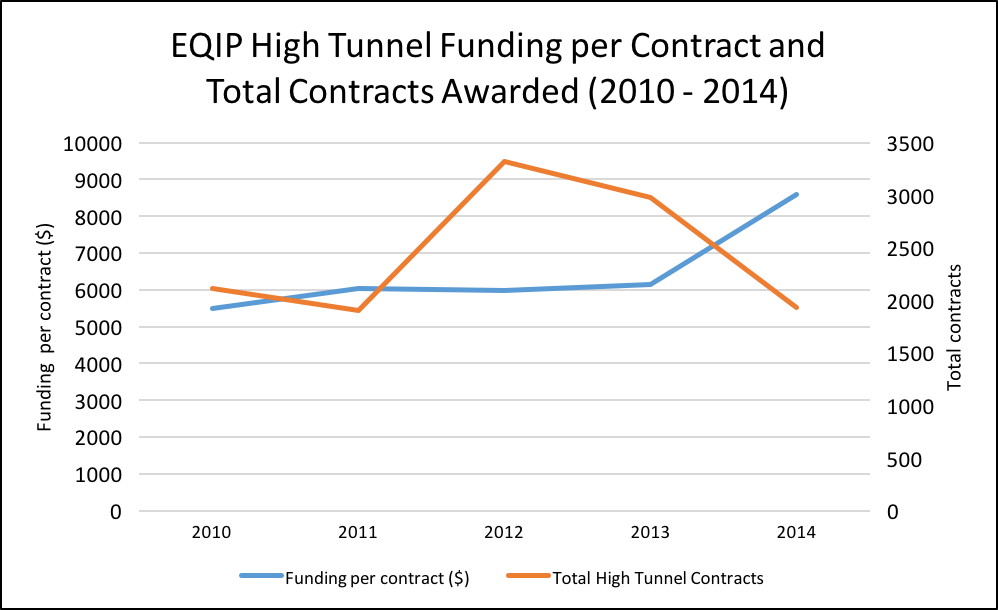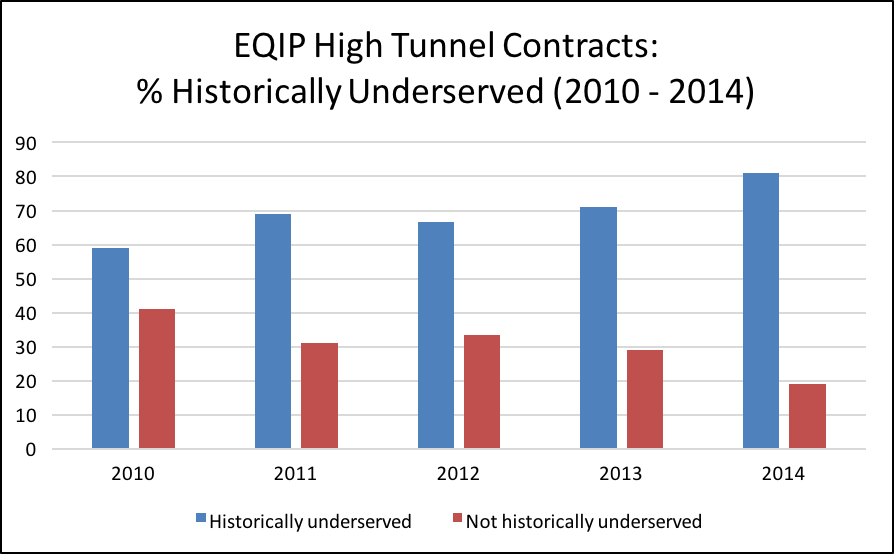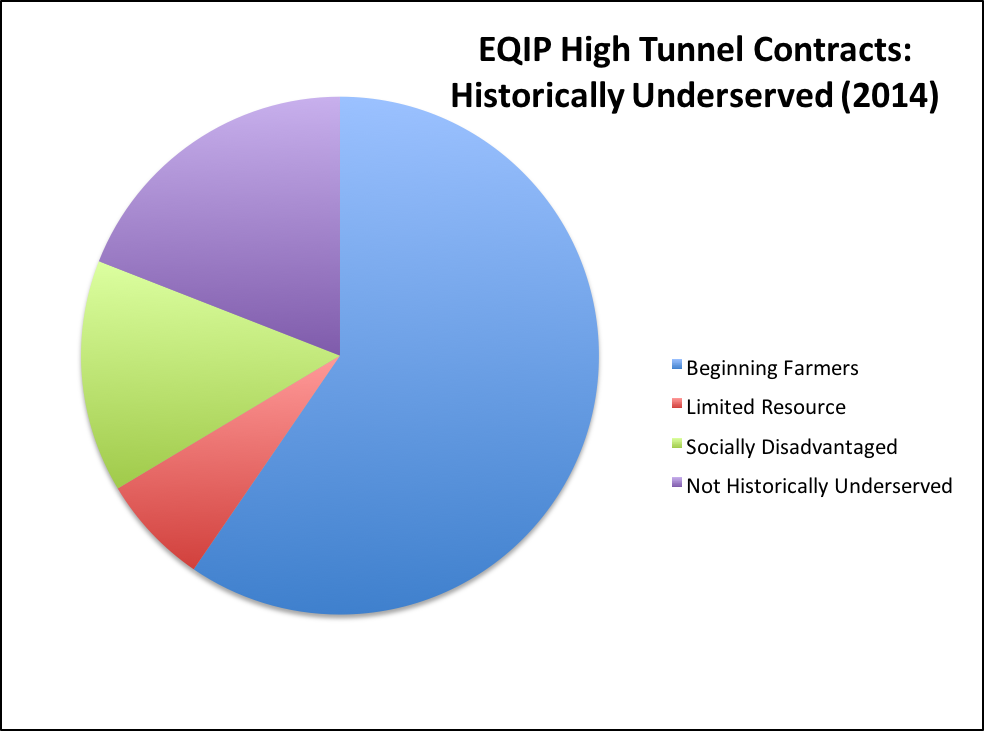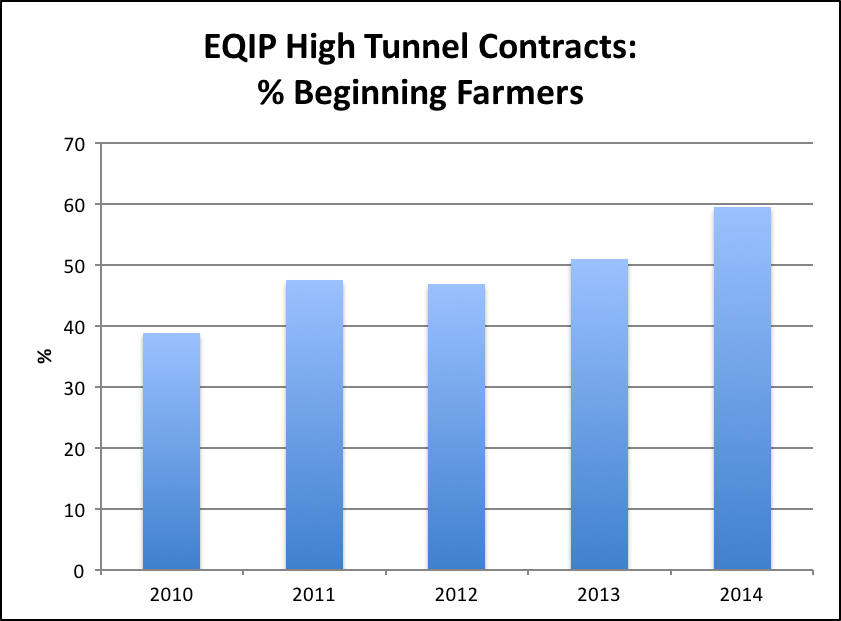Jacob and Courtney Cowgill of Prairie Heritage Farm grow fresh vegetables, heritage turkeys, ancient and heritage grains, and lamb in Central Montana. Farming up where the Rocky Mountains meet the plains means that their land is exposed to fierce winds and long winters, presenting unique challenges for their Community Support Agriculture (CSA) and wholesale production in the Great Falls area.
To address these challenges, the Cowgills applied for the Environmental Quality Incentives (EQIP) Seasonal High Tunnel Initiative, which offers cost-share funding and technical assistance to farmers who want to extend the growing season on their farms by using high tunnels.
The Cowgills first applied for the program when it was still a pilot project in 2010, and recently received cost-share funding for a second high tunnel that they’re now in the process of constructing. They were only in their second year of farming when they applied the first contract, and so received a higher payment rate as beginning farmers.

Jacob explained the clear benefits for their operation:
“Where we are it gets pretty windy – the crops get beat up by the wind. The high tunnels protect the crops, and allow us to provide earlier vegetables for our CSA customers, as well as get kale and chard into wholesale markets before the summer farmers’ markets even begin. This was an incredible opportunity for us as beginning farmers, and we couldn’t have done it without the cost-share support through EQIP.”
Program Overview
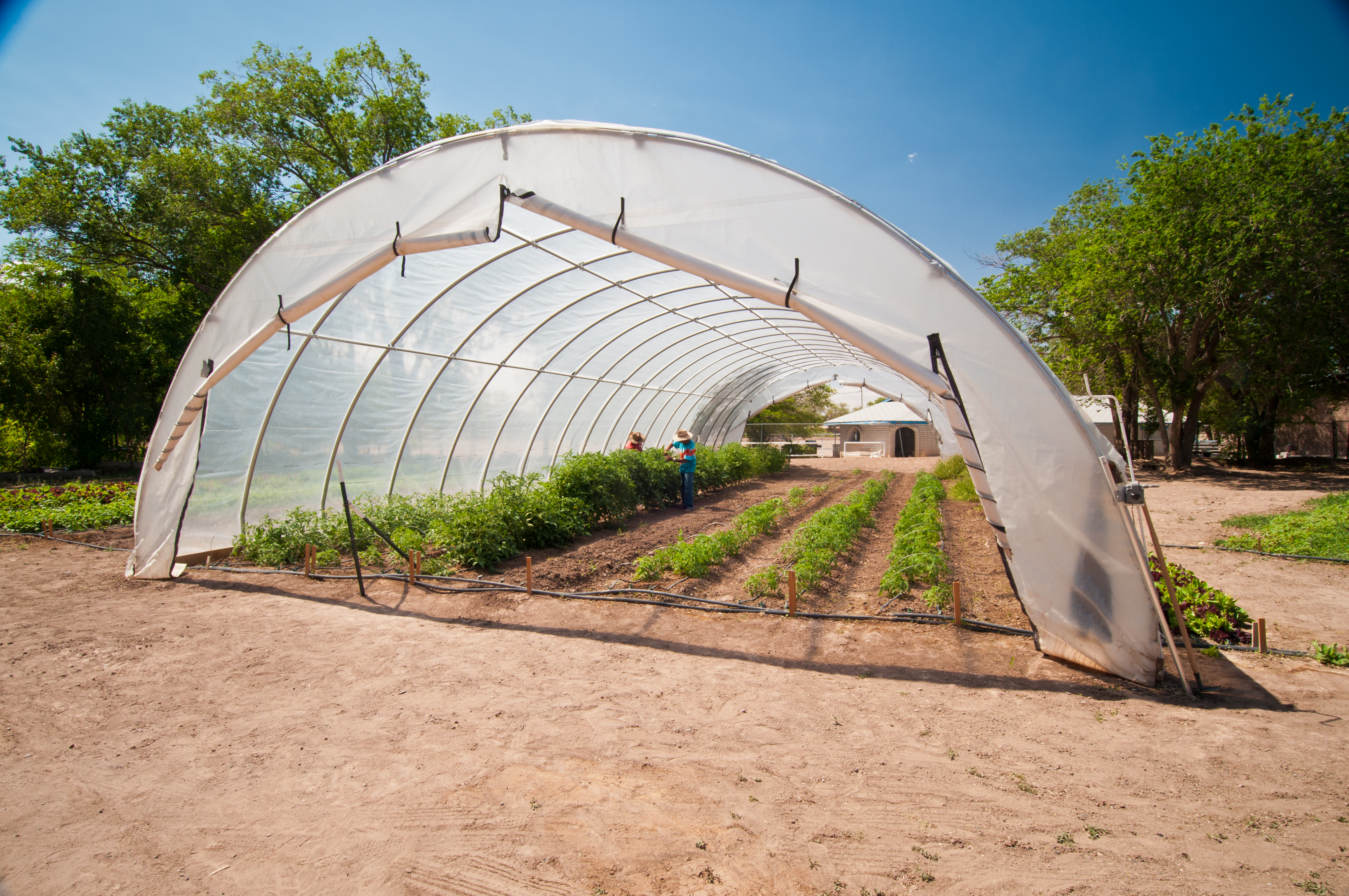
Last year we provided an update on the Seasonal High Tunnel Initiative, which is a special initiative within EQIP. EQIP is a voluntary conservation program created by the federal farm bill and administered by the U.S. Department of Agriculture (USDA)’s Natural Resources Conservation Service (NRCS) that assists farmers and ranchers through financial cost-share and technical assistance to implement a wide range of conservation practices on working agricultural land.
This update again focuses in on the Seasonal High Tunnel Initiative to highlight clear benefits and trends for historically underserved groups of farmers (beginning, socially disadvantaged, and limited resource) as well as overall conservation benefits.
High tunnels (also known as hoop houses) are structures that modify the growing environment through the construction of hoops covered with plastic, which are placed over the growing area. Unlike some greenhouses, high tunnels require no energy, because they rely on natural sunlight to modify the inside climate. This creates favorable growing conditions for producing vegetables and specialty crops.
Prior to 2014, EQIP high tunnels were an interim conservation practice standard, established through a pilot project that was designed to help NRCS assess the environmental benefits that may result from the use of high tunnels for crop production.
In fiscal year 2014, after three years of continued growth and interest in the program, the seasonal high tunnel switched over to become an established conservation practice standard (#798 in the NRCS numbering system).
Between 2010 and 2014, the EQIP Seasonal High Tunnel Initiative has provided assistance for over 12,000 high tunnels in all fifty states as well as Puerto Rico and the Pacific Basin. During this period the program has obligated over $77 million in cost shares to support the construction of high tunnels.
High Tunnel Contracts in 2014
In fiscal year 2014, NRCS awarded 1,936 high tunnel contracts, which, as the chart below illustrates, is a significant drop from the nearly 3,000 contracts awarded in 2013.
While we can’t be certain what is driving this decreased high tunnel participation, we suspect that the trend may be influenced by recent changes in size limitations and program administration, both of which went into effect for FY 2014.
- Size Limitation: The high tunnel pilot program initially set a maximum size of 2,178 square feet (5 percent of an acre) of high tunnel that could be funded through NRCS, based on the payment per foot rate. Many producers found this size limit to be restrictive, and beginning in FY 2014, the cap was lifted. As the chart below illustrates, while overall high tunnel contracts dropped in 2014, the average funding per contract increased significantly, indicating that producers opted to take advantage of the opportunity for larger hoop houses. While this presents an opportunity for increased season extension production, the National Sustainable Agriculture Coalition (NSAC) is concerned about the implications for smaller-scale applicants who may have been turned away as a result.
- Funding Distribution: Another programmatic change that went into effect in FY 2014 is that funding for the Season High Tunnel Initiative now comes out of states’ general funds. Previously a specific allocation for the initiative went to each state and was rolled over if funds weren’t used. High tunnels remain available to farmers in all states, but states now have the option of whether or not to make it a special initiative with its own separate pool of funds. NSAC’s view is the specific allocation should continue in future fiscal years to counteract the effect of removing the size limitation.
Not surprisingly, in 2014, high tunnels were popular in states with relatively shorter growing seasons, such as Alaska, Michigan, Maine, and New York. Some states, such as Kentucky, Indiana, and Maryland, did not have any high tunnel contracts during the program’s first two years, but increased significantly through FY 2014. These dramatic shifts likely illustrates the critical role that state NRCS offices play in promoting the program, which is all the more important following the shift in how states allocate funds.
Historically Underserved
Despite the overall decline in high tunnel (and overall EQIP) contracts in 2014, the percentage of high tunnel contracts awarded to beginning, socially disadvantaged, or limited resource producers, collectively referred to as historically underserved producers, continues to grow.
High tunnel EQIP payments are made to producers based on a set rate per foot of high tunnel constructed. Historically underserved producers are eligible for a higher payment rate within all statewide and county level programs under EQIP. For example, in Oregon, the payment per square foot of high tunnel constructed was $2.90 for general participants, and $3.48 for historically underserved participants.
On top of this payment rate differentiation, five percent of all EQIP funds are set-aside in a designated pool for beginning farmers and ranchers, and an additional five percent is set-aside for socially disadvantaged producers. Furthermore, this same population of producers is also eligible for up to 50 percent advance payment for costs associated with planning, design, materials, equipment, installation, labor, management, maintenance, or training – further incentivizing their participation in EQIP. Each of these special EQIP provisions were developed and advanced by NSAC and congressional champions for new farmers in previous farm bills.
Promoting and incentivizing the high tunnel program to historically disadvantaged producers makes good sense. It ensures that farmers who face the greatest barriers to accessing capital and farmland can also participate and benefit from season extension and related conservation practices. These producers often explain that extending the growing season enables them to tap into critical markets at times when they would otherwise be unable to supply any produce. The special incentives go hand-in-hand with the strong desire of many young and beginning farmers to serve local and regional food markets.
In 2014, over 80 percent of all EQIP fund allocated for seasonal high tunnels were awarded to historically underserved producers. As the chart below illustrates, this is up from 70 percent in 2013, following a steady increasing trend from 2010. Furthermore, in comparing participation rates for historically underserved and all other producers between 2010 and 2014, this gap has grown increasingly larger over time.
Within this group of historically underserved producers, beginning farmers represent the largest portion of EQIP high tunnel contracts. In 2014, beginning farmers (those farmers who have been farming for 10 years or less), received 60 percent of all contracts awarded that included the seasonal high tunnel initiative.
As the chart below illustrates, this percentage of beginning farmers has been steadily increasing since 2010.
The 1,153 contracts awarded to beginning farmers in 2014 provided over $10 million in cost-share assistance to support their season extension efforts.
This high percentage of beginning farmers is well above their overall EQIP participation rate, which in 2014 was just over 20 percent of all EQIP contracts awarded to beginning farmers and ranchers. The funding that went to beginning farmers for the high tunnel initial represents about 6 percent of all EQIP funds awarded to beginning farmers and ranchers.
Breaking these beginning farmer numbers down by state, Wyoming, Alaska, Missouri, Montana, and Massachusetts had the highest percentage of all high tunnel contracts awarded to beginning farmers – all above 85 percent of total contracts.
Conservation and Seasonal High Tunnels
NRCS initially established high tunnels as an interim standard to assess environmental benefits that may result from the use of the tunnels, as farmers take steps to control runoff, save water, limit pesticide use, and engage in other conservation measures. The high tunnel’s controlled environment has implications for water conservation, pest management, and energy usage.
On top of these benefits, data shows that many farmers with EQIP high tunnel contracts are also implementing other conservation practices on their land. In 2014, high tunnel contract holders also implemented more than 60 other EQIP conservation practices, such as nutrient management, cover crops, and integrated pest management.
For instance, of all high tunnel contract holders in FY 2014, 15 percent simultaneously held a contract for nutrient management, which provides a roadmap to help producers apply nutrient sources in the right amount and at the right time to obtain the maximum agricultural and environmental benefits. Nutrient requirements are based on NRCS- approved nitrogen and phosphorus risk assessments.
High tunnel users also used cover crops on their land, with 8 percent of contract holders also implementing the cover crop conservation practice in order to prevent erosion, improve soil health, provide nutrients, suppress weeds, increase soil water content, and break pest cycles.
Additionally, many 2014 high tunnel contract holders signed up for the Integrated Pest Management (IMP) conservation standard, which is an ecosystem-based strategy, enabling farmers to identify and reduce risk from pests using pest-management related strategies. IPM provides producers with an alternative to intensive, conventional pesticide use.
On top of these practices, many beginning farmers cite their EQIP high tunnel contracts as the way they were pulled “into the loop” as far as other conservation funding streams available through NRCS. They may go on to receive funding for their cover crop seeds, or other mulching and tilling projects. In this way the EQIP Seasonal High Tunnel Initiative serves as an introduction for many beginning farmers to grow into leading stewards, supported by a wide range of NRCS program funding.
Advancements in the type of high tunnels that EQIP can support also have conservation benefits. For instance, Jacob pointed out that their most recent contract will be a movable high tunnel that can shift on a track to three different locations throughout the year.
“This will allow us to protect tomatoes early in the season, and when they eventually freeze we can shift over to protect spinach in the fall, exposing the ground to the winter moisture, ultimately benefiting the soil. Not only that, but we can also cover crop in one of the high tunnel positions, further returning critical nutrients and improving overall soil health.”
Jacob explained that their new high tunnel contract also includes practices like cover cropping, irrigation water management, and nutrient management.
EQIP Initiatives and Program Funding
The EQIP Seasonal High Tunnel Initiative is one of several EQIP initiatives that highlight specific practices or natural resources. For example, the EQIP Organic Initiative provides separate funding pools for transitioning and certified organic producers.
NSAC will continue to report on these opportunities for producers through EQIP. We expect NRCS to publish the final EQIP rule in the next few months, and we hope to see important recommendations that NSAC provided on the interim final rule reflected in the final rule, including eliminating limits that restrict funding for organic and transitioning to organic producers, as well as preventing EQIP funding to go to new or expanding concentrated animal feeding operations (CAFOs).
Despite the fact that the 2014 Farm Bill reauthorized EQIP with permanent, mandatory funding, we continue to see an assault on this funding through the appropriations process year after year. Most recently, the House Agriculture Appropriations Subcommittee passed its funding bill for FY 2016, which included a $300 million (or 18 percent) cut to EQIP funding.
NSAC will continue to oppose these back-door cuts in the Senate and final versions of the agriculture spending bill. EQIP and other conservation funding is critical to support farmers, ranchers, and foresters who are working to conserve soil, water, and other resources on and around their land.
How to Apply
States may establish their own application periods in which to consider eligible applications for funding. Farmers interested in constructing a seasonal high tunnel through EQIP should contact their local NRCS office.



